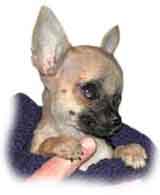Small Dog BreedsInformation About The Pekingese Dog Breed |
|
|
The Pekingese has a compact, sturdy, short-legged body with protruding eyes and long ears. He has a shedding coat that is long, straight, and dense with a thick undercoat. This breed has been a pampered lapdog that fancies himself as a tiny emperor and also likes to remind his owner of his regal background. He is loyal, intelligent, affectionate, and expects to be petted and pampered. However, he is not at all a delicate nature. He is a brave guard dog that is fearless, fun, and loves playing with toys. He is good with children provided he is raised with them from puppy hood. He is a great companion dog for the elderly because of his low exercise requirements and his tendency to bond closely to just 1 or 2 persons. He has a controlling temperament and is not aware of the concept of owner dominance. His independent nature makes him one of the most difficult of the toy breeds. He has the tendency to bite if he is annoyed or pushed. His owner should be persistent and patient when training this dog because he can be stubborn and will not often cooperate during training. It is no wonder that this breed is almost never seen in the obedience ring. Spoiling will exaggerate his narcissistic nature and may result in aggression. In fact, most of his snooty behavior comes from the tendency of their owners spoiling them. He is very suspicious of strangers and other dogs. He is susceptible to ear infections and eye injuries and is sensitive to extremes in temperature. Size: The Pekingese stands 8-9in at the shoulder and weighs between 10-14lb. History and origin: The Pekingese is an ancient Chinese breed that was brought back to Europe after the Boxer Rebellion. In 1860, when the British invaded the Summer Palace of Peking, 5 Imperial Pekingese were looted from the women's apartments. Before the invasion, this dog was forbidden for anyone to own other than the Chinese Royal family and their theft was punishable by death. This breed has always been a companion dog. Feeding: Recommended feeding for this breed is 6-8oz of meat supplemented with biscuits and an occasional non-splintery bone. Similar to most breeds, he likes vitamin tablets and will beg for them like sweets. Unlimited supply of water is essential for this breed as well as all breeds. Exercise: An apartment is adequate for the Pekingese. This breed requires regular but minimal exercise. Grooming: His coat needs to be brushed using a brush with soft bristles and combed everyday. In addition, his coat must be kept dry to prevent matting. Many owners prefer to keep the coat cut short to simplify maintenance.Back to the Small Dog Breed page
| |
|
Related News About Dogs ' ); // get rid of newsfeed display by carp CarpConf('poweredby',''); CarpCacheShow('http://www.small-dog-info.com/support-files/rss.xml'); ?>
|
|
|
|
|
|
Copyright © 2006-2007 dogguidance.com |


